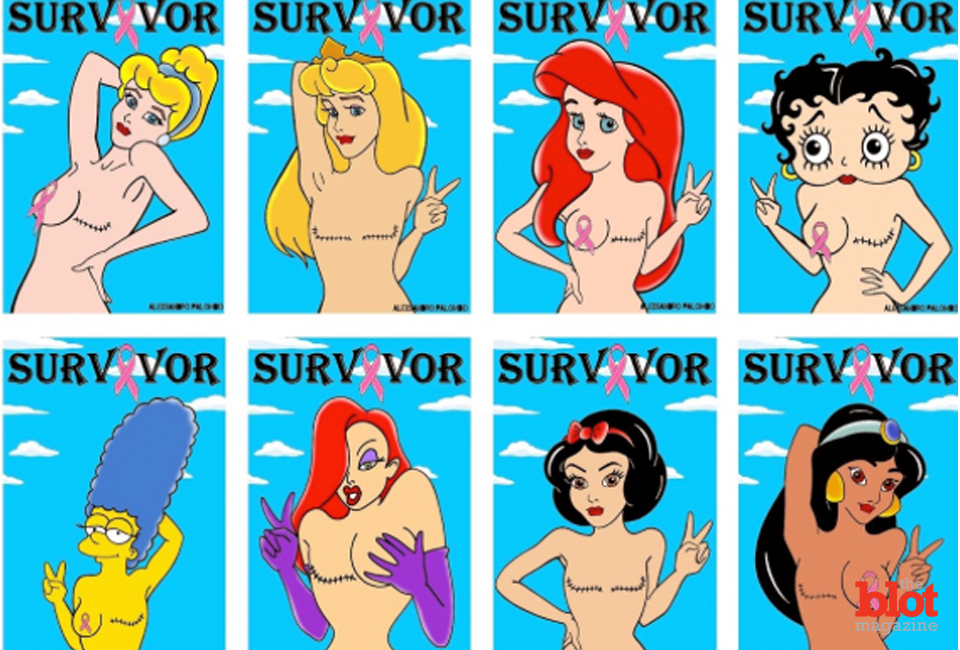
Breast Cancer Awareness Month just passed, but I’d like to keep the focus on it yearlong. There is a wonderful man in Milan, Italy, who is both artist and activist. His name is AleXsandro Palombo, and he created a series of cartoon princesses — but with a twist: They all have mastectomy scars.
Palombo refers to these artworks as “humor chic,” and you’ll recognize all of the familiar female faces from art icons that include Snow White, Marge Simpson, Jessica Rabbit, Wilma Flintstone and more.
It was an honor to speak to the artist about this project and his many other controversial art series.
Dorri Olds: What inspired your breast cancer survivors cartoon series?
AleXsandro Palombo: Every woman is beautiful, even after a mastectomy, and women should know that. I put order to the codes of beauty. A few years ago, a colleague of mine died from breast cancer. I think you really have to invest great energy in the prevention and create more awareness. If caught early, you can win upon this disease. The acceptance of your own body mutilated by a mastectomy is one of the most devastating moments of the disease. You must be very strong to be able to react psychologically and accept the new appearance of your body. My message is one of hope and courage. I believe that we must create awareness to young people and teach health education. Breast cancer is a disease that can affect younger women, too.
What sparked your Disney princesses with disabilities series?
Two years ago, I had a rare form of cancer. After the surgery to remove it, parts of my own body remained paralyzed. In the last three years, it has been difficult for me to move because I spend a lot of time in the hospital for rehabilitation. My best therapy for life’s illness is art. I wanted to give visibility to a problem that affects a great amount of people all over the world. It’s a message against discrimination, a message to redefine the standards of beauty.
The major industries of marketing and media impose a false perfection. Diversity is not allowed. When you are a big company like Disney, you have a great responsibility toward the children that watch and learn from the messages you launch. Including, for example, a disabled protagonist who can surely create acceptance in a world where disabled children suffer all forms of discrimination and humiliation. Disability is part of our world, but unfortunately, too many people think that it is something ugly that you have to hide.
What inspired your series on domestic abuse victims?
We live in a society where women are treated like objects. In advertising campaigns, in the fashion magazines, in the TV, there’s a continuous bombardment of this type of “women as objects,” and personally I find it humiliating. We must begin to reverse this trend. We must subvert it, because if you don’t educate people to respect women, then everything will continue to be superficial.
Have you ever seen a very normal couple walking on the street, and then with a glimpse of the women’s face, you see she is bruised? In many cases, monsters are apparently very normal people. And in too many cases, women are ashamed to ask for help. Sometimes they believe that it’s their own fault, and they feel trapped in silence, and the violence goes on undisturbed. Look at the Indian women that are fighting against male abuse. They are very courageous, and I very much admire them all.
It should be men that fight against the men who abuse women all over the world. The law must ensure that these individuals are severely punished. We must never lower our attention to this important problem. There are no women immune to the violence, even if they are strong. I want my social artwork to slap faces with reality and be an inspiration to fight violence.

What inspired your cartoons of fashion icons like Anna Wintour and Karl Lagerfeld?
I hope to convince them to ban the use of real fur because it’s a massacre that cannot be accepted by a civil and modern society.
Can you explain your #FreeGaza project?
It’s horrific that the people of Gaza are forced to live in an inhuman condition, enclosed in a fence, and that’s why I strongly condemn the Palestinian terrorists of Hamas. Their violence against the Israeli people is unacceptable.
When did you first become interested in activism?
I started to be an activist when I was 14. I was a volunteer in dogs shelters, I brought food to hundreds of dogs. Then the Red Cross. Then I volunteered in the Italian Marines for two years; I have participated in important international peacekeeping missions. I’ve seen so much despair and suffering … mine is a vocation that comes from deep inside.
Are you concerned that Disney could sue you?
No. These are the stars of our time, popular icons just like some big stars. I draw them with my language and my imagination, just like Andy Warhol did with some divas and socialites in his day. I am a contemporary artist who explores the society. The cult of celebrity is an important part of my work, but my art also focuses on the social aspects of society and fights for the right of expression, freedom and equality. I’m an activist who always faces strong and controversial issues through art with my own artistic language. I mix color, iconic cartoon characters, satirism, humor, realism and surrealism. This way, I try to entertain and make people reflect in the same time. My artworks are like a mirror, the cultural expression of the society in which we live.
Do you exhibit your artwork in the United States?
For now I prefer the Internet. That is by far the largest gallery in the world.
Dorri Olds is a contributing journalist for TheBlot Magazine.





